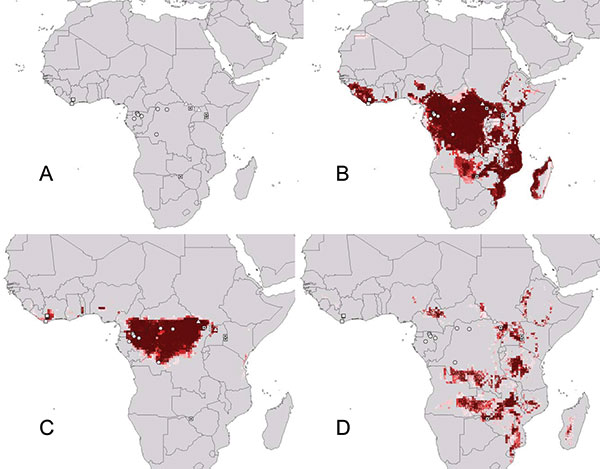Volume 10, Number 1—January 2004
Research
Ecologic and Geographic Distribution of Filovirus Disease
Figure 1

Figure 1. Summary of known and predicted geography of filoviruses in Africa. (A) Known occurrence points of filovirus hemorrhagic fevers (HFs) identified by virus species. (B) Geographic projection of ecologic niche model based on all known filovirus disease occurrences in Africa. (C) Geographic projection of ecologic niche model based on all known Ebola HF occurrences (i.e., eliminating Marburg HF occurrences). (D) Geographic projection of ecologic niche model based on all known occurrences of Marburg HF (i.e., eliminating Ebola HF occurrences). Darker shades of red represent increasing confidence in prediction of potential presence. Open squares, Ebola Ivory Coast; circles, Ebola Zaire; triangles, Ebola Sudan; dotted squares, Marburg HF occurrences.
1Although filovirus taxonomy undergoes frequent revision, we follow nomenclature most recently established by the International Committee of Taxonomy of Viruses in 2002. Filoviruses consist of two genera. The genus Marburgvirus contains one species, Lake Victoria marburgvirus, with several recognized strains, and Ebolavirus contains four species: Ivory Coast ebolavirus, Reston ebolavirus, Sudan ebolavirus, and Zaire ebolavirus. For simplicity, we refer to the viruses using the unitalicized vernacular (e.g., Ebola Zaire). We use “Ebola viruses” to refer in general to members of Ebolavirus and “Marburg viruses” to refer in general to members of Marburgvirus. The diseases caused by filoviruses are termed Ebola hemorrhagic fever (HF; diseases caused by Ebola viruses) and Marburg HF (diseases caused by Marburg viruses).